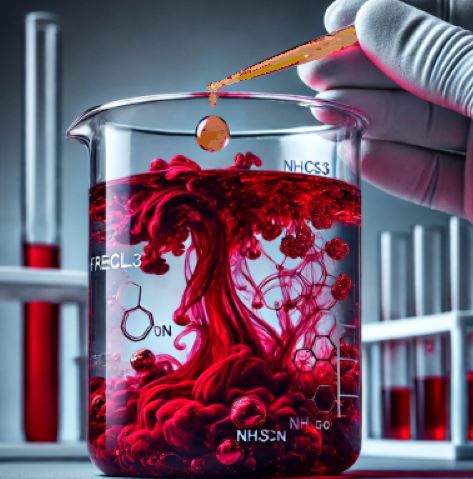Blood-Red Reaction
Back to Schedule 2023
"Blood-red reaction" or the formation of a red coordination complex using ammonium thiocyanate (NH₄SCN) and iron(III) chloride (FeCl₃) produces a deep red color similar to blood, which is due to the formation of an iron-thiocyanate complex.
Materials Needed:
- Ammonium thiocyanate (NH₄SCN)
- Iron(III) chloride (FeCl₃) solution
- Distilled water
- Two small beakers or test tubes
- Stirring rod (optional for mixing)
- Dropper or pipette
Safety Precautions:
- Wear gloves, goggles, and a lab coat for safety, as both iron(III) chloride and ammonium thiocyanate can be irritants.
- Dispose of chemicals properly according to your lab's safety procedures.
Procedure:
Prepare the iron(III) chloride solution:
- Dissolve a small amount of FeCl₃ in distilled water. About 0.1 M concentration should suffice. It will appear as a pale yellow solution.
Prepare the ammonium thiocyanate solution:
- Similarly, dissolve some NH₄SCN in distilled water to create a 0.1 M solution. The solution will be colorless or very faintly colored.
Perform the reaction:
- In a clean beaker or test tube, add a few milliliters of the iron(III) chloride solution.
- Using a dropper or pipette, add a few drops of the ammonium thiocyanate solution to the iron(III) chloride solution.
Observe the reaction:
- Immediately, you will notice the solution turning deep blood-red. This color is due to the formation of the iron(III)-thiocyanate complex: , which has a characteristic deep red color.
Chemical Reaction:
The reaction between ammonium thiocyanate and iron(III) chloride can be represented by the following equation:
This is an example of a coordination complex formation, where the iron(III) ion () reacts with the thiocyanate ion () to form the blood-red iron(III)-thiocyanate complex .
Explanation:
- Iron(III) chloride provides ions.
- Ammonium thiocyanate provides ions.
- When these ions combine, they form the complex ion , which has a distinctive deep red color, resembling blood.
Applications and Extensions:
- This reaction is often used in chemical demonstrations to illustrate complex ion formation or equilibrium reactions in chemistry.
- It can also be used as a simple chemical test for the presence of iron(III) ions or thiocyanate ions.
This experiment is simple and effective, demonstrating an interesting visual change while also teaching important concepts related to transition metal chemistry.
.
Back to Schedule 2024
